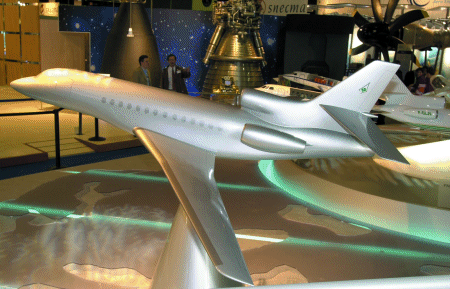One of the world's fastest business jet will put routes such as Paris-Tokyo in reach of corporate travellers
Dassault Aviation has formally launched the long-range, Mach 0.9 FNX, the first member in a new family of Falcon business jets. The 10,500km (5,700nm)-range fly-by-wire trijet is due to fly in 2004, leading to first deliveries in mid-2006.
Unveiling the aircraft at the show, Dassault chairman and chief executive Charles Edelstenne said: "We don't want to go into the transonic or supersonic domain and as for competition from airlines with Mach 0.95 capability, we think that is a red herring."

The Mach 0.9 maximum speed means the FNX will be the fastest long-range business jet available, although Boeing says it will look at scaling down its Mach 0.95-98 sonic cruiser development "if it makes sense".
The FNX features a new high-speed wing with 5° higher sweep and 1.86m (11.4ft) longer span than the Falcon 900 wing. The aircraft has the same cabin cross-section as the 900, but a 20% longer fuselage. Behind the new curved windscreen will be the EASy cockpit under development for the Falcon 900EX and 2000EX and based on Honeywell Primus Epic avionics.
Selection of the powerplant is expected within months, with Honeywell's all new FX5 competing against a growth version of Pratt & Whitney Canada's PW306 turbofan. Three engines will provide a combined thrust of 18,000lb (80kN).
The FNX's range - 10,500km at Mach 0.88, up from the 900EX's 8,300km at Mach 0.84 - will allow the trijet to operate sectors such as Paris-Tokyo, New York-Honolulu and San Francisco-Moscow.
Bombardier and Gulfstream believe their long-range business jets, the Global Express and GV, respectively, are already fast enough to satisfy market demand. The Global Express can cruise at Mach 0.88, while the GV-SP, now under development, has a design range of 12,500km at Mach 0.8, but will still fly 9,000km at Mach 0.87.
Dassault says that "other types" in the FNX family are under evaluation, although the manufacturer declines to elaborate on what or how many variants may be under consideration.
Source: Flight International
















